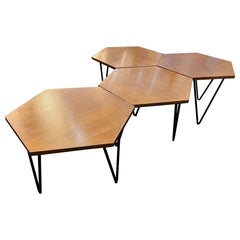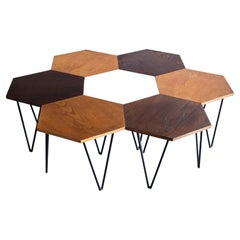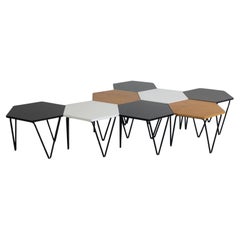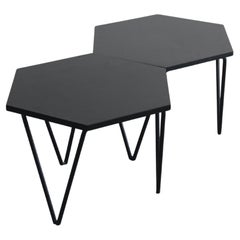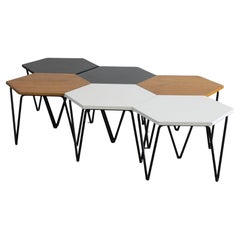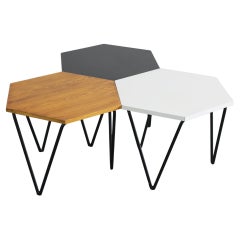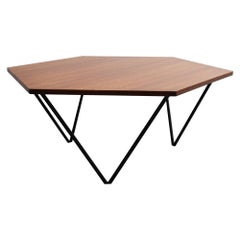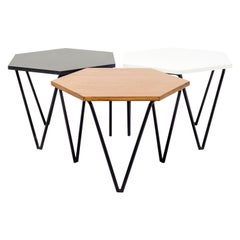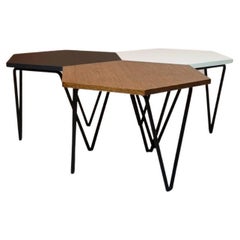Gio Ponti Hexagon Table
Mid-20th Century Italian Side Tables
Metal
Vintage 1950s Italian Mid-Century Modern Coffee and Cocktail Tables
Iron
Vintage 1950s Italian Mid-Century Modern Coffee and Cocktail Tables
Metal
Vintage 1950s Italian Mid-Century Modern Coffee and Cocktail Tables
Metal
Vintage 1950s Italian Mid-Century Modern Coffee and Cocktail Tables
Metal
Vintage 1950s Italian Mid-Century Modern Coffee and Cocktail Tables
Metal
Vintage 1950s Italian Mid-Century Modern Coffee and Cocktail Tables
Iron
Recent Sales
Vintage 1950s Italian Mid-Century Modern Coffee and Cocktail Tables
Metal
Vintage 1950s Italian Mid-Century Modern Tables
Metal
Vintage 1960s Italian Mid-Century Modern Coffee and Cocktail Tables
Metal
Vintage 1950s Italian Mid-Century Modern Coffee and Cocktail Tables
Iron
Vintage 1950s Italian Mid-Century Modern Coffee and Cocktail Tables
Iron
Vintage 1950s Italian Mid-Century Modern Coffee and Cocktail Tables
Iron
Vintage 1950s Italian Mid-Century Modern Coffee and Cocktail Tables
Wood
Vintage 1950s Italian Mid-Century Modern Coffee and Cocktail Tables
Metal
Vintage 1950s Italian Mid-Century Modern Coffee and Cocktail Tables
Metal
Vintage 1950s European Mid-Century Modern Coffee and Cocktail Tables
Hardwood
Vintage 1950s Italian Mid-Century Modern Coffee and Cocktail Tables
Wrought Iron
Vintage 1950s Italian Mid-Century Modern Coffee and Cocktail Tables
Metal
Vintage 1950s Italian Mid-Century Modern Coffee and Cocktail Tables
Enamel, Steel
Vintage 1950s Italian Mid-Century Modern Coffee and Cocktail Tables
Wrought Iron
Vintage 1960s Italian Mid-Century Modern Side Tables
Iron
Mid-20th Century Italian Mid-Century Modern Side Tables
Metal
Vintage 1950s Italian Mid-Century Modern Coffee and Cocktail Tables
Iron
Vintage 1950s Italian Mid-Century Modern Coffee and Cocktail Tables
Metal
Vintage 1950s Italian Mid-Century Modern Tables
Iron
People Also Browsed
Vintage 1970s Italian Mid-Century Modern Wardrobes and Armoires
Brass, Bronze
Vintage 1980s Swiss Post-Modern Sofas
Chrome
Vintage 1940s German Mid-Century Modern Wall Lights and Sconces
Brass
Vintage 1950s Italian Mid-Century Modern Wall Mirrors
Brass
Vintage 1950s French Mid-Century Modern Wall Lights and Sconces
Aluminum, Brass
Vintage 1960s Italian Mid-Century Modern Dining Room Chairs
Brass, Iron
Late 20th Century Italian Industrial Chandeliers and Pendants
Art Glass, Blown Glass, Murano Glass
Vintage 1950s Italian Mid-Century Modern Office Chairs and Desk Chairs
Brass, Iron
21st Century and Contemporary Polish Organic Modern Wall Mirrors
Ceramic, Mirror
21st Century and Contemporary French Sofas
Leather
21st Century and Contemporary American Art Nouveau Doors and Gates
1990s Italian Lounge Chairs
Wicker
Vintage 1940s French Art Deco Cabinets
Wood
Mid-20th Century Italian Mid-Century Modern Beds and Bed Frames
Metal, Chrome
Vintage 1940s Italian Mid-Century Modern Daybeds
Velvet, Walnut
Mid-20th Century Italian Mid-Century Modern Console Tables
Brass, Iron
Gio Ponti Hexagon Table For Sale on 1stDibs
How Much is a Gio Ponti Hexagon Table?
Gio Ponti for sale on 1stDibs
An architect, furniture and industrial designer and editor, Gio Ponti was arguably the most influential figure in 20th-century Italian modernism.
Ponti designed thousands of furnishings and products — from cabinets, mirrors and chairs to ceramics and coffeemakers — and his buildings, including the brawny Pirelli Tower (1956) in his native Milan, and the castle-like Denver Art Museum (1971), were erected in 14 countries. Through Domus, the magazine he founded in 1928, Ponti brought attention to virtually every significant movement and creator in the spheres of modern art and design.
The questing intelligence Ponti brought to Domus is reflected in his work: as protean as he was prolific, Ponti’s style can’t be pegged to a specific genre.
In the 1920s, as artistic director for the Tuscan porcelain maker Richard Ginori, he fused old and new; his ceramic forms were modern, but decorated with motifs from Roman antiquity. In pre-war Italy, modernist design was encouraged, and after the conflict, Ponti — along with designers such as Carlo Mollino, Franco Albini, Marco Zanuso — found a receptive audience for their novel, idiosyncratic work. Ponti’s typical furniture forms from the period, such as the wedge-shaped Distex chair, are simple, gently angular, and colorful; equally elegant and functional. In the 1960s and ’70s, Ponti’s style evolved again as he explored biomorphic shapes, and embraced the expressive, experimental designs of Ettore Sottsass Jr., Joe Colombo and others.
Ponti's signature furniture piece — the one by which he is represented in the collections of the Museum of Modern Art in New York, Germany’s Vitra Design Museum and elsewhere — is the sleek Superleggera chair, produced by Cassina starting in 1957. (The name translates as “superlightweight” — advertisements featured a model lifting it with one finger.)
Ponti had a playful side, best shown in a collaboration he began in the late 1940s with the graphic artist Piero Fornasetti. Ponti furnishings were decorated with bright finishes and Fornasetti's whimsical lithographic transfer prints of things such as butterflies, birds or flowers; the Montreal Museum of Fine Arts possesses a 1950 secretary from their Architetturra series, which feature case pieces covered in images of building interiors and facades. The grandest project Ponti and Fornasetti undertook, however, lies on the floor of the Atlantic Ocean: the interiors of the luxury liner Andrea Doria, which sank in 1956.
Widely praised retrospectives at the Queens Museum of Art in 2001 and at the Design Museum London in 2002 sparked a renewed interest in Ponti among modern design aficionados. (Marco Romanelli’s monograph, which was written for the London show, offers a fine overview of Ponti’s work.) Today, a wide array of Ponti’s designs are snapped up by savvy collectors who want to give their homes a touch of Italian panache and effortless chic.
Find a range of vintage Gio Ponti desks, dining chairs, coffee tables and other furniture on 1stDibs.
A Close Look at Mid-century-modern Furniture
Organically shaped, clean-lined and elegantly simple are three terms that well describe vintage mid-century modern furniture. The style, which emerged primarily in the years following World War II, is characterized by pieces that were conceived and made in an energetic, optimistic spirit by creators who believed that good design was an essential part of good living.
ORIGINS OF MID-CENTURY MODERN FURNITURE DESIGN
- Emerged during the mid-20th century
- Informed by European modernism, Bauhaus, International style, Scandinavian modernism and Frank Lloyd Wright’s architecture
- A heyday of innovation in postwar America
- Experimentation with new ideas, new materials and new forms flourished in Scandinavia, Italy, the former Czechoslovakia and elsewhere in Europe
CHARACTERISTICS OF MID-CENTURY MODERN FURNITURE DESIGN
- Simplicity, organic forms, clean lines
- A blend of neutral and bold Pop art colors
- Use of natural and man-made materials — alluring woods such as teak, rosewood and oak; steel, fiberglass and molded plywood
- Light-filled spaces with colorful upholstery
- Glass walls and an emphasis on the outdoors
- Promotion of functionality
MID-CENTURY MODERN FURNITURE DESIGNERS TO KNOW
- Charles and Ray Eames
- Eero Saarinen
- Milo Baughman
- Florence Knoll
- Harry Bertoia
- Isamu Noguchi
- George Nelson
- Danish modernists Hans Wegner and Arne Jacobsen, whose emphasis on natural materials and craftsmanship influenced American designers and vice versa
ICONIC MID-CENTURY MODERN FURNITURE DESIGNS
- Eames lounge chair
- Nelson daybed
- Florence Knoll sofa
- Egg chair
- Womb chair
- Noguchi coffee table
- Barcelona chair
VINTAGE MID-CENTURY MODERN FURNITURE ON 1STDIBS
The mid-century modern era saw leagues of postwar American architects and designers animated by new ideas and new technology. The lean, functionalist International-style architecture of Le Corbusier and Bauhaus eminences Ludwig Mies van der Rohe and Walter Gropius had been promoted in the United States during the 1930s by Philip Johnson and others. New building techniques, such as “post-and-beam” construction, allowed the International-style schemes to be realized on a small scale in open-plan houses with long walls of glass.
Materials developed for wartime use became available for domestic goods and were incorporated into mid-century modern furniture designs. Charles and Ray Eames and Eero Saarinen, who had experimented extensively with molded plywood, eagerly embraced fiberglass for pieces such as the La Chaise and the Womb chair, respectively.
Architect, writer and designer George Nelson created with his team shades for the Bubble lamp using a new translucent polymer skin and, as design director at Herman Miller, recruited the Eameses, Alexander Girard and others for projects at the legendary Michigan furniture manufacturer.
Harry Bertoia and Isamu Noguchi devised chairs and tables built of wire mesh and wire struts. Materials were repurposed too: The Danish-born designer Jens Risom created a line of chairs using surplus parachute straps for webbed seats and backrests.
The Risom lounge chair was among the first pieces of furniture commissioned and produced by celebrated manufacturer Knoll, a chief influencer in the rise of modern design in the United States, thanks to the work of Florence Knoll, the pioneering architect and designer who made the firm a leader in its field. The seating that Knoll created for office spaces — as well as pieces designed by Florence initially for commercial clients — soon became desirable for the home.
As the demand for casual, uncluttered furnishings grew, more mid-century furniture designers caught the spirit.
Classically oriented creators such as Edward Wormley, house designer for Dunbar Inc., offered such pieces as the sinuous Listen to Me chaise; the British expatriate T.H. Robsjohn-Gibbings switched gears, creating items such as the tiered, biomorphic Mesa table. There were Young Turks such as Paul McCobb, who designed holistic groups of sleek, blond wood furniture, and Milo Baughman, who espoused a West Coast aesthetic in minimalist teak dining tables and lushly upholstered chairs and sofas with angular steel frames.
Generations turn over, and mid-century modern remains arguably the most popular style going. As the collection of vintage mid-century modern chairs, dressers, coffee tables and other furniture for the living room, dining room, bedroom and elsewhere on 1stDibs demonstrates, this period saw one of the most delightful and dramatic flowerings of creativity in design history.
Finding the Right Coffee-tables-cocktail-tables for You
As a practical focal point in your living area, antique and vintage coffee tables and cocktail tables are an invaluable addition to any interior.
Low tables that were initially used as tea tables or coffee tables have been around since at least the mid- to late-1800s. Early coffee tables surfaced in Victorian-era England, likely influenced by the use of tea tables in Japanese tea gardens. In the United States, furniture makers worked to introduce low, long tables into their offerings as the popularity of coffee and “coffee breaks” took hold during the late 19th century and early 20th century.
It didn’t take long for coffee tables and cocktail tables to become a design staple and for consumers to recognize their role in entertaining no matter what beverages were being served. Originally, these tables were as simple as they are practical — as high as your sofa and made primarily of wood. In recent years, however, metal, glass and plastics have become popular in coffee tables and cocktail tables, and design hasn’t been restricted to the conventional low profile, either.
Visionary craftspeople such as Paul Evans introduced bold, geometric designs that challenge the traditional idea of what a coffee table can be. The elongated rectangles and wide boxy forms of Evans’s desirable Cityscape coffee table, for example, will meet your needs but undoubtedly prove imposing in your living space.
If you’re shopping for an older coffee table to bring into your home — be it an antique Georgian-style coffee table made of mahogany or walnut with decorative inlays or a classic square mid-century modern piece comprised of rosewood designed by the likes of Ettore Sottsass — there are a few things you should keep in mind.
Both the table itself and what you put on it should align with the overall design of the room, not just by what you think looks fashionable in isolation. According to interior designer Tamara Eaton, the material of your vintage coffee table is something you need to consider. “With a glass coffee table, you also have to think about the surface underneath, like the rug or floor,” she says. “With wood and stone tables, you think about what’s on top.”
Find the perfect centerpiece for any room, no matter what your personal furniture style on 1stDibs — shop Art Deco coffee tables, travertine coffee tables and other antique and vintage coffee tables and cocktail tables today.
